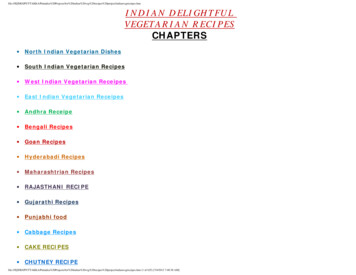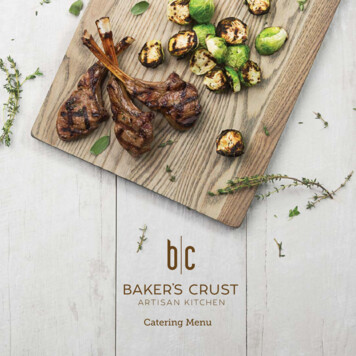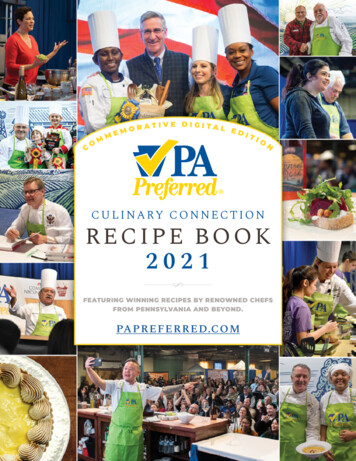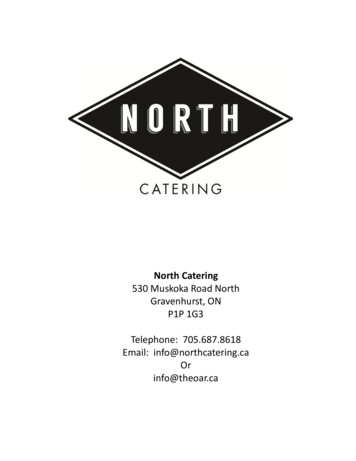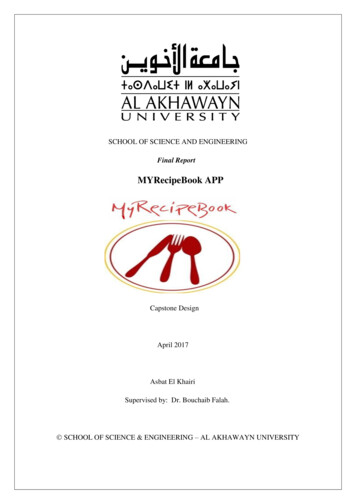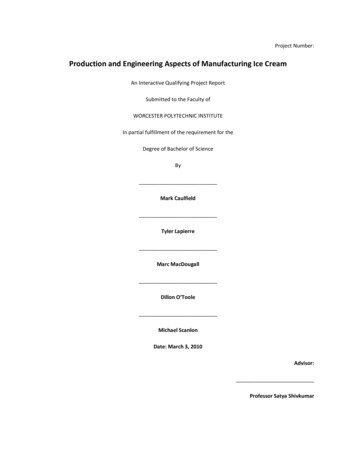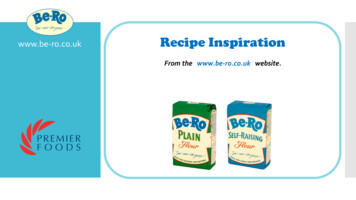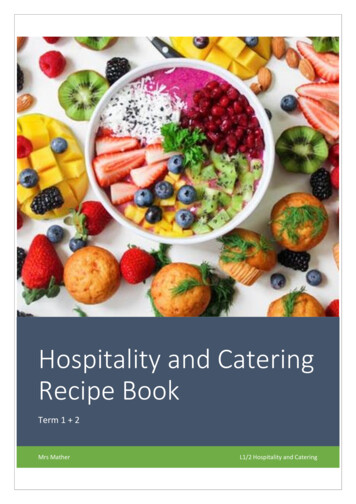
Transcription
Hospitality and CateringRecipe BookTerm 1 2Mrs MatherL1/2 Hospitality and Catering
Chapter 1: NutrientsChicken Fajitas Assessment criteriaPractical: Fajitas for TeenagersLearning Objectives:To prepare, cook and serve a healthy main meal suitable for a teenager.To apply a variety of technical skills and make creative and quality products with skill andprecision.It is important teenagers have a varied and balanced diet asshown in the Eatwell Guide. Some nutrients to be aware of:1. Iron2. Vitamin D3. CalciumLowL1Fajitas usingreadymadecomponentsLots of shop boughtcomponents used eg preparedveg, grated cheese, readymade salsa, diced chickenMediumP/MHomemadesauce, chickenmarinatedGood knife skills demonstrated (vegetablepreparation and dicing chicken)Homemade marinade and saucesComplexM/DMrs Mather’s Fajita success criteria:Chickendeboned andmarinated.HomemadeflatbreadsKnife skills show precision (vegetable and/or chicken preparation).All served on homemade flatbread with suitable homemadeaccompaniments. Presented to an excellent standard.It is important to try and prevent Enzymic browning when making a guacamole. Explainthe process of Enzymic browning and suitable ways to prevent it.Assessment Criteria:Complex: Chicken, de boned, marinated, meat and vegetables prepared correctly and cooked withprecision. Served on homemade flatbread with a range of homemade sauce and accompanimentse.g. salsa, guacamole and salad. All technical skills and processes executed and fajitas presented toan excellent standard. Meets all sections of Eatwell guide.Medium: Chicken marinated and seasoned. Meat and vegetables prepared and cooked to a goodstandard and served with tortilla wrap and served with a suitable dip / accompaniment. All skillsand processes executed effectively and fajitas presented to good standard. Meets most sections ofEatwell Guide.Basic: Chicken and vegetables are prepared and cooked to a basic standard. Use of readymadesauce or Fajita kit used and no accompaniments.Skills, processes and presentation are basic and meet some of Eatwell guide sections
Chicken FajitasSuitable meal for a teenager – following Eatwell GuideIngredients: Serves 2Juice of half a lime1 clove garlic½ green chilli or ½ tsp chilli powder1 small chicken breast1 small onion½ a pepper (green, red or yellow)2 tortilla wrapsOptional1 tomato25g cheddar cheeseGuacamole, soured cream or salsa to serve½ tsp smoked paprikaSmall bunch fresh corianderEquipment: Lemon squeezer, Garlic press, Sharp knife, Brown chopping board, Red Choppingboard, Medium bowl, Tablespoon, Grater, Frying panMethod1. Mise en place (Collect all ingredients and equipment, prepare working areaand prepare the marinade): Squeeze the lime Peel and crush the garlic De-seed and slice the chilli Chop the fresh coriander Stir everything together with the oil with any additional spices.2. On a red chopping board cut the chicken in to strips.3. Mix the chicken in the bowl with the marinade and set aside. (If doing this athome, cover the bowl and place in the fridge until needed).4. Wash the sharp knife in hot soapy water and dry and prepare the remainingingredients with a clean knife on a brown chopping board: Slice the onion and pepper in to thin strips Chop the tomato in to 1cm cubes (approx.) Grate the cheese.5. Add the marinated chicken to the frying pan and stir-fry for about 4 minutesand check that the chicken is cooked through (750c).6. Add the onion and pepper and continue to cook for another 2 minutes.7. Warm the tortillas in a microwave oven for 20 seconds on a clean plate.8. Spread a little chicken mixture in the centre of the tortilla, add some tomato,cheese and guacamole/salsa/soured, cream if using.
Jamie’s Flatbreads – Wraps for fajitasIngredients 350g Self-raising flour 1 teaspoon baking powder 350g Natural yogurtGarlic and herb butter (optional) 2 cloves garlic Bunch of fresh herbs (such as flat-leafparsley, tarragon, basil, dill) 40g unsalted butterMethod1. Add all the flatbread ingredients to a mixing bowl and mix together with a spoon,then use clean hands to pat and bring everything together.2. Dust a clean work surface with flour, then tip out the dough.3. Knead for a minute or so to bring it all together (this isn’t a traditional breadrecipe, so you don’t need to knead it for long – just enough time to bringeverything together).4. Put the dough into a floured-dusted bowl and cover with a plate, then leaveaside.5. If making the garlic butter: peel the garlic cloves and crush them with a garliccrusher.6. Pick the herb leaves onto a chopping board and finely chop them, discarding thestalks.7. Melt the butter in a small pan over a medium heat, then stir through the garlicand chopped herbs, then set aside.8. Dust a clean work surface and rolling pin with flour, then divide the dough in half,then divide each half into 6 equal-sized pieces (roughly the size of a golf ball).9. With your hands, pat and flatten the dough, then use a rolling pin to roll eachpiece into 12cm rounds, roughly 2mm to 3mm thick.10. Use a knife to cut 6 lines into the centre of each round, leaving about 3cm ateach end.11. Place the griddle pan on a high heat, then once hot, cook each one for 1 to 2minutes on each side, or until bar-marked and puffed up, turning with tongs.12. Brush the flatbreads all over with herby garlic butter as they come off the griddle
Fish Pie Recipe(High biological value proteins practical)Ingredients – serve 3-4Topping:350g potatoes30g butter or margarine25ml milkSeasoning15g grated cheddar cheese1 tomato – sliced (optional)Fish250g haddock or other white fish(e.g. Pollock, whiting, hake, cod)50g peas or sweetcornSmall bunch dill (optional)Béchamel Sauce25g unsalted butter or margarine25g plain flour300ml milkMethod1. Potato Toppinga) Peel and chop the potatoes into small chunksb) Place in a pan of water and boil for 15-20 minutes until the potatoes are softc) Drain the water away and mash the potatoes with butter/margarine and milk until they aresmooth2. Fisha. While the potatoes are boiling, prepare the fishb. Wash the fish in cold water and place it on some kitchen foil and bake at 180oc for 1520 minutes (alternatively, poach the fish in a milk pan for a couple of minutes until it iscooked).c. Carefully remove the fish and place it on a plate. Break the fish into small pieces with aknife and fork, remove any skin and check carefully for any small bones.3. Béchamel saucea. In a small saucepan, melt the butter on the hob – do not let it burn.b. Add thef lour and continue heating it, stirring all the time for 1 minute (to cook off theflavour of the flour) - Rouxc. Remove the pan from the heatd. Gradually add the milk to the roux, stirring well each time to avoid any lumps forminguntil all the milk has been added.e. Put the pan back on the heat and stirring all the time, heat the sauce until it boils andthickens – the sauce should coat the back of the spoon and be smooth and glossy inappearance.f. Remove the pan from the heat.4. Assemble the fish pie
a.b.c.d.e.f.Mix the peas or sweetcorn in to the sauce.Chop the dill leaves with kitchen scissors or a knife.Place the fish in the bottom of an ovenproof dish.Scatter the dill leaves over the fish.Pour the sauce over the fish and mix gently with a fork.Spread the mashed potato evenly over the fish and sauce. You could use a piping bagand star nozzle to pipe the potato on to give a different finish.g. If you are using a tomato, slice it thinly and arrange the slices neatly on the top of thepotato.h. Sprinkle the top with grated cheese5. Bake in the oven at 190oc for 20 minutes or until the top has brownedOr place under a hot grill for a few minutes to brown the top.There are some concerns that some types of fish that we eatregularly have been over fished, so that the stocks that are left in the sea are indanger of being made extinct. Find out what ‘fish from sustainable sources’means, and which types of sustainable fish could be used as alternatives to tunaand haddock in the recipe.
Fishcake Recipe(High biological value proteins practical)Ingredients – Serves 4350g potatoes200g canned tuna or cooked fish (e.g. haddock)25g butter or margarine1 eggSmall bunch parsley / 1tsp dried parsley200g dried breadcrumbs or stale breadFlour for shaping the fish cakes (school provides)Black pepperMethod1. Peel the potatoes and cut in to 1cm dice.2. Place the potatoes in a large pan, cover with cold water and bring to the boil. Simmer for 20minutes or until the potatoes are soft.3. Open the can of tuna or cooked fish, put in to a bowl and flake with a knife and fork.4. Wash the parsley, remove stalks and chop finely.5. When the potatoes are cooked, drain and mash them with a potato masher until smooth.6. Add the butter or margarine, fish and parsley, season with black pepper and mix well with aspoon.7. Crack the egg into a small bowl and beat with a fork.8. Place the breadcrumbs on a plate.9. Sprinkle some flour on your chopping board and hands. Shape the fish mixture into a sausageshape and then cut and shape into eight even-sized pieces.10. Dip each fishcake into the egg mixture, brushing with a pastry brush.11. Remove with a palette knife, place into the breadcrumbs and coat each side evenly.12. Bake the fish cakes on a lined baking tray for 15-20 minutes at Gas 6/200oc (190oc if using a fanoven) until golden and crispy on the outside.HBV / LBV Protein Practical Assessment CriteriaComplex: Fish filleted and all bones removed with no excess waste, fish and vegetables prepared correctlyand cooked with precision. Homemade sauce and potato mashed and piped on top. All technical skills andprocesses executed and fish pie presented to an excellent standard.Meets all sections of Eatwell guide.Medium: Skin removed from a filleted fish with some waste. Fish and vegetables prepared and cooked to agood standard and served in a homemade sauce with mashed potato topping. All skills and processesexecuted effectively and fish pie presented to good standard. Pie meets most sections of Eatwell guide.Basic: use of pre filleted fish. Fish and vegetables are prepared and cooked to a basic standard. Use ofreadymade sauce and basic potato topping. Skills, processes and presentation are fairly basic and dish meetsome of Eatwell guide sections.
Carrot Cakes – makes 12 cupcakes(High fibre / low sugar cakes)150g margarine250g carrots200g light brown sugar200g plain flour100g wholemeal flour2 x tsp cinnamon2 x tsp baking powder2 large eggsOptional extras 50g dried fruit e.g. sultanas Zest of one orangeCream cheese icing 50g cream cheese 25g icing sugarMethod1. Preheat the oven to 180oC or gas mark 52. Melt the margarine in the microwave or in a saucepan3. Top and tail and then peel and grate the carrots4. Combine the carrots, sugar and melted margarine in the mixing bowl.5. Sift in the flour, cinnamon and baking powder6. Beat the eggs in a small bowl, and then add to the mixture7. Mix in any other ingredients – e.g. sultanas and nuts8. Divide the mixture equally between 12 muffin cases9. Bake in the oven for 15 minutes10. Once the cakes have cooled, combine 50g of cream cheese and 25g of icingsugar in a bowl and spread carefully on top of the cakes.To increase the fibre content, you could swap the plain flour for wholemeal flour,add walnuts in to the sponge mix / or on top for decoration, add dried fruit to themixture, add chopped apple to the mixture / on top, leave the skin on the carrotswhen grating (wash carrots before use)To reduce the sugar, you could swap some of the sugar for a mashed up banana /use some artificial sweetener (this weighs much less than sugar!).To add more skill, you could pipe your icing on to the cakes or consider morecreative flavour combinations / adaptations
Courgette, Onion and Cheese Muffins(High fibre / low sugar muffins)Ingredients: (serves 12 people)225g self-raising flour (wholemeal is higher in fibre)50ml oil175ml semi-skimmed milk1 egg100g Cheddar cheese1 small courgette (skin left on is higher in fibre)1 small onionblack pepperYou will also need:12 muffin casesmuffin tinStorage instructions:Allow to cool then place in an airtight tin or plastic box for up to 3–5 days. Oncecooked, they can be frozen and warmed in an oven to defrost.Method1. Preheat the oven to Gas 6/200 C (190 C if you are using a fan oven).2. Peel and finely chop the onion.3. Wash then cut off the ends of the courgette and grate it into a mixing bowlwith the cheese and the onion.4. Add the flour, oil, milk and beaten egg and season with ground black pepper.5. Mix the ingredients together with a spoon to form a batter.6. Divide the batter equally between the muffin cases using two spoons.7. Bake for 20 minutes, until well risen and golden brown in colour.8. Serve warm or cold. Could be served with soup or stews.What other flavours or toppings could you add to these muffins?How could the fibre content be increased further?
Roasted Mediterranean Vegetable Tart(Shortcrust pastry practical)IngredientsPastry150g plain wholemeal flour, or white flour or half and half (75g of each)75g butter or vegetable fat spread8 tsp (40ml) cold waterFilling1 pepper1 courgette1 small onion1 tomato or 2 medium mushrooms2 tbsp olive oil1 clove garlica few basil leaves2 medium eggs150ml milk100g mature Cheddar cheese, gratedground black pepper23–25cm ovenproof flan tin or dishMethod1. Heat the oven to Gas 6/200 C (190 C if you are using a fan oven).2. Roasted vegetables: Wash and dice the onion, pepper, courgette, tomato andmushrooms all to the same size.3. Mix the vegetables in a bowl with the olive oil, crushed garlic and ½ tsp blackpepper.4. Arrange the vegetables on a baking tray and roast them in the oven for 25–30minutes until lightly browned and tender. Halfway through the cooking time, stirthem around with a wooden spoon to ensure that they cook evenly.5. While the vegetables are cooking, make the pastry.6. Pastry: Rub the butter or vegetable fat spread into the flour, using your fingertips,until it looks like breadcrumbs. (Fat coats the flour to give it a waterproof coating)7. Add the water and mix to a dough. If you are short of time, this could be made inthe food processor.
8. Lightly knead the dough with your fingertips until it is smooth, then roll it out on afloured work surface and line the flan tin or dish, taking care not to stretch thepastry.9. If you have time, give the pastry time to rest in the fridge for 15 minutes to allowthe gluten molecules to relax, which will reduce the risk of the pastry shrinking inthe oven.10. Put some baking paper in the flan case and add some baking beans to hold itdown. Bake the pastry case ‘blind’ (without the filling) for 15 minutes. It should becooked and crisp.11. Carefully remove the baking beans and paper. If the base of the flan looksundercooked, return it to the oven for a further 5 minutes.12. Turn the oven down to Gas 5/190 C (180 C if you are using a fan oven).13. Place the flan tin/dish on a baking tray.14. Place half of the grated cheese in the cooked pastry case.15. Place the roasted vegetables on top of the grated cheese and add the roughlychopped basil leaves.16. Mix the eggs and milk together and pour them over the vegetables.17. Add the rest of the cheese and bake the flan for 25 minutes until the filling hasset and the top is a golden brown colour.18. Serve warm or cold with a fresh, crisp salad.Storage instructions:Refrigerator: When cooled, store in the refrigerator for up to 5 days.Freezer: The flan can be frozen once it has cooled for up to 4 months.Variations: Try varying the vegetables that you use. Could you add a protein source?Try different cheeses (e.g. a blue veined cheese such as Stilton or Red Leicester).
Smoked Mackerel Pate(Soup / Salad / Starter, rich in specified vitamin)Ingredients1 medium fillet of smoked mackerel (ready to eat)25g butter50g crème fraiche or cream cheese or soured cream or plain yogurt½ a lemonBlack pepper to seasonMethod1. Melt butter in a small pan for a few seconds and leave to cool slightly.2. Remove the skin and bones from the fish and break it into small flakes with aknife and fork.3. Zest half a lemon and squeeze the juice of half a lemon.4. In a mixing bowl, put the fish, melted butter, crème fraiche/creamcheese/soured cream or yogurt, the zest and juice of the lemon and ¼ tsp blackpepper.5. Mix everything together thoroughly with a fork or spoon (if you would like asmoother texture you could use a food processor).6. Place in to a bowl, cover and put in the fridge until ready to serve.7. Serve with toasted bread and garnish with a lemon slice and some choppedparsley or a sprinkling of paprika.Page 29 of AQA Textbooks explains the nutritional content of this recipe .
Crunchy watercress and orange salad(Soup / Salad / Starter, rich in specified vitamin)Ingredients: (serves 4)2 orangesBunch or bag of watercress30g pumpkin seeds2 tbsp olive oilFreshly ground black pepper.Method:1. Carefully and thoroughly wash the watercress and allow it to drain.2. Wash the oranges and finely grate the zest of one of them.3. Carefully cut the skin and white pith from the oranges with a sharp knife. Savethe juice that is produced.4. Cut the segments from the oranges and put them in a bowl. Remove any seeds ormembrane that separates the segments. If the segments are large you can cutthem in half.5. Dressing: Mix the olive oil with 1tbsp of the orange juice, some ground blackpepper and 1tsp of grated orange zest.6. Put the pumpkin seeds into a frying pan (without oil) and heat them gently,shaking them around in the pan until they start to toast and ‘pop’. Add a littlesalt and pepper if you wish. Take them off the heat and aside until ready to use.7. Mix the watercress, orange segments and dressing together in a bowl and tip into a serving dish. Scatter the pumpkin seeds and the remaining grated orangezest on top.8. Serve as an accompaniment to other salads and main meals.
Lasagne (Rich in calcium vitamin D practical)Ingredients1 onion1 garlic clove1 carrot1 tbsp. oil250g lean minced beef1 tin chopped tomatoes (400g)1 tbsp. tomato puree100ml water1 tsp. mixed herbsBlack pepper6 lasagne sheets25g butter / margarine25g plain flour300ml semi-skimmed milk50g cheddar cheesePasta Ingredients2 eggs – 1 whole 1 yolk140g ‘00’ flour (Plain flour will also work)Pasta Method1. Add eggs and flour to a food processor and blitz until well combined. (The mixture shouldresemble ‘breadcrumbs’ at this stage).2. Remove the blade from the food processor carefully and scrape out the pasta dough.3. Knead lightly on a clean work surface to combine the pasta dough.4. Wrap the ball of dough in cling film and rest for 30 minutes to allow the gluten to relax.Lasagne Filling1. Preheat the oven to 190 C or gas mark 5.2. Prepare the vegetables: peel and chop the onion; peel and crush the garlic; peel and slice the carrot.3. Fry the onion, garlic, carrot and celery in the oil.4. Add the meat and cook until the mince is lightly browned.5. Add the tomatoes, tomato puree, mixed herbs and water and mix all the ingredients together.Then add a few twists of black pepper.6. Bring to the boil, then simmer for 20 minutes.While the meat is cooking, prepare the lasagne sheets5. Divide the dough in half (keep one half wrapped in cling film until ready to roll).6. Roll the pasta dough in to a rectangle with a rolling pin.7. Then use the pasta machine to roll the pasta sheets to the required thickness – Begin on thelargest setting and reduce the size each time, making the pasta thinner and thinner.8. Cut the pasta sheets to the length of your lasagne dish and set aside until ready to roll.Béchamel sauce1. Place the butter or margarine, flour and milk into a small saucepan.2. Bring the sauce to a simmer, whisking it all the time until it has thickened.3. Reduce the heat and simmer for 2 minutes.4. Grate the cheese and stir in to the sauce (leave a little to sprinkle on top).Assembling the lasagne1. In an ovenproof dish or foil tray, spread some meat mixture in the bottom, cover with lasagnesheets and a little cheese sauce. Repeat this, finishing with the sauce on top.2. Sprinkle the remaining grated cheese on top and bake in the oven for 20 minutes.
Practical: Homemade pasta dishLearning Objectives:To prepare, cook and serve a main meal that is a good source of energy.To learn how to make pasta from raw ingredients.Ingredients to make pasta:1 whole egg1 egg yolk140g ’00 or plain flourComplex6-9Medium3-5LowL1Mrs Mather’s pasta success criteria:Homemadepasta withreadymadesauceHomemadepasta withtomatoreductionsauceRavioli withtomato sauceMaking,shaping andcooking pastaMaking, shaping and cooking pastasuccessfully, vegetable preparation, knifeskills, making tomato sauce or bolognesefrom raw ingredientsMaking and rolling pasta.Making ravioli filling, assembling, sealing and cooking ravioli.Vegetable preparation, making tomato sauce using the reduction method.Excellent attention to detail and presented to an excellent standard.1. Explain which methods of heat transfer have been used to cook your chosen pasta dish.2. What is the nutritional value of your chosen pasta dish?AQA Assessment Criteria:Complex: Competent execution of skill and processes to an excellent standard. Selective use of a range ofequipment with precision and accuracy. Dish shows a high level of challenge and complexity. Dish shows awide range of finishing techniques such as garnishing and decoration. All dishes are presented withexcellent attention to detail and finished to an excellent standard. Excellent use of time plans andapplication of hygiene and safety.Medium: A range of skills to good standard. Equipment used with some accuracy. Dish shows some level ofdemand and uses a range of finishing techniques to garnish and decorate. Presentation is good and dish isfinished to a good standard. Good use of time plans and hygiene and safety.Basic: Some basic skills and processes used with some inaccuracies during making. Basic use of equipmentand dish shows some demand but limited use of skill to cook and present. Limited hygiene and safety.
Fresh PastaIngredients 140g plain flour or Italian '00' flour2 eggs (1 whole egg 1 egg yolk)Method1. Separate the 1 egg yolk from the egg white.2. Mix the egg yolk in with 1 whole egg, in a jug with a fork.3. Place the flour in a food processor and pulse it. Add the whole egg and egg yolk keep whizzinguntil the mixture resembles fine breadcrumbs (it shouldn't be dusty, nor should it be a big,gooey ball). This takes 2-3 minutes.4. Tip out the dough and knead to form into a ball shape. Knead it briskly for 1 minute, it shouldbe quite stiff and hard to knead. Wrap in cling film and leave to rest in a cool place for 20minutes - 1 hour before using.5. Now cut the dough into 2 pieces. For each piece, flatten with a rolling pin so it will fit throughthe widest setting on the pasta machine.6. Now you are ready to roll out. Start with the pasta machine at its widest setting, pass thedough through the rollers. Do not fold but repeat this process, decreasing the roller settingdown grade by grade with each pass. For most uses, I take the pasta down to around no.4, sothat you can see shadows through the pasta sheets.7. Bring a pan of water to the boil, add your shaped pasta and cook for 2-3 minutes. The pastashould float to the surface once cooked.Choose a suitable sauce recipe to serve with your pasta.Prepare your sauce whilst the pasta is resting in the fridge and do NOT cook the pasta until yoursauce is cooked and ready to use.Assessment criteria to consider when choosing a pasta recipe:BASIC: Grade 1-3 Pasta in tomato sauce: using ready-made pasta. Spaghetti bolognaise: using ready-made pasta, jar of tomato sauce, chopping vegetables. Pasta salad: using dried pasta, cooked chicken, appropriate vegetables and mayonnaise.MEDIUM: Grade 4-6 Tagliatelle: making pasta and cream sauce e.g. carbonara. Tagliatelle: making pasta with a homemade pasta sauce e.g. Bolognese / ragu Pasta salad: using dried pasta, chicken cooked from raw, homemade salad dressing andvegetable preparation showing good knife skills.COMPLEX: Grade M/D Ravioli: making pasta, shaping and filling ravioli and homemade tomato sauce. Lasagne: making own pasta, meat sauce and roux sauce. Pasta salad: using homemade pasta, chicken cooked from raw, precision cut vegetables and ahomemade emulsion e.g. mayonnaise.
Lasagne (with homemade pasta sheets)Ingredients1 onion1 garlic clove1 carrot1 tbsp. oil250g lean minced beef1 tin chopped tomatoes (400g)1 tbsp. tomato puree100ml water1 tsp. mixed herbsBlack pepper6 lasagne sheets25g butter / margarine25g plain flour300ml semi-skimmed milk50g cheddar cheesePasta Ingredients2 eggs – 1 whole egg 1 egg yolk140g ‘00’ flour (Plain flour will also work)Pasta Method9. Add eggs and flour to a food processor and blitz until well combined. (The mixture shouldresemble ‘breadcrumbs’ at this stage).10. Remove the blade from the food processor carefully and scrape out the pasta dough.11. Knead lightly on a clean work surface to combine the pasta dough.12. Wrap the ball of dough in cling film and rest for 30 minutes to allow the gluten to relax.Lasagne Filling1. Preheat the oven to 190 C or gas mark 5.2. Prepare the vegetables: peel and chop the onion; peel and crush the garlic; peel and slice the carrot.3. Fry the onion, garlic, carrot and celery in the oil.4. Add the meat and cook until the mince is lightly browned.5. Add the tomatoes, tomato puree, mixed herbs and water and mix all the ingredients together.Then add a few twists of black pepper.6. Bring to the boil, then simmer for 20 minutes.While the meat is cooking, prepare the lasagne sheets13. Divide the dough in half (keep one half wrapped in cling film until ready to roll).14. Roll the pasta dough in to a rectangle with a rolling pin.15. Then use the pasta machine to roll the pasta sheets to the required thickness – Begin on thelargest setting and reduce the size each time, making the pasta thinner and thinner.16. Cut the pasta sheets to the length of your lasagne dish and set aside until ready to roll.Béchamel sauce5. Place the butter or margarine, flour and milk into a small saucepan.6. Bring the sauce to a simmer, whisking it all the time until it has thickened.7. Reduce the heat and simmer for 2 minutes.8. Grate the cheese and stir in to the sauce (leave a little to sprinkle on top).Assembling the lasagne3. In an ovenproof dish or foil tray, spread some meat mixture in the bottom, cover with lasagnesheets and a little cheese sauce. Repeat this, finishing with the sauce on top.4. Sprinkle the remaining grated cheese on top and bake in the oven for 20 minutes.
Practical: Special dietary needs layered dessertLearning Objectives:To create, prepare, cook and serve a layered dessert which has been adapted to meet a chosendietary need.To apply a variety of technical skills and make some creative and quality products with skill andprecision.Special Dietary Needs:1. Vegetarian including vegans.2. Coeliac (gluten intolerance).3. Lactose intolerant (milk).4. High fibre (NSP: Non starch Polysaccharide).5. Reduced sugar or salt.6. Reduced fat.LowTrifle usingreadymadecomponentsSlicing sponge,layering, packetmix custard,whipping creamMediumTrifle withhomemadecustardLayering the trifle, preparing and cutting fruit,whipping the creamHomemade custard with successful results(Thickened sauce using egg and cornflour)ComplexMrs Alton’s trifle success criteria:Trifle withhomemadecustard andtrifle spongesLayering the trifle, preparing and cutting fruit, whipping the cream, successfulhomemade custard,Homemade trifle sponges or swiss roll (piped or rolled accurately)Cream piped on to the top of trifle and garnished to an excellent standard*Must be able to explain how your dessert is suitable for the special dietary need you have chosenExplain the science. How do egg and cornflour thicken custard?AQA Assessment Criteria:Complex: Competent execution of skill and processes to an excellent standard. Selective use of a range ofequipment with precision and accuracy. Dish shows a high level of challenge and complexity. Dish shows awide range of finishing techniques such as garnishing and decoration. All dishes are presented withexcellent attention to detail and finished to an excellent standard. Excellent use of time plans andapplication of hygiene and safety.Medium: A range of skills to good standard. Equipment used with some accuracy. Dish shows some level ofdemand and uses a range of finishing techniques to garnish and decorate. Presentation is good and dish isfinished to a good standard. Good use of time plans and hygiene and safety.Basic: Some basic skills and processes used with some inaccuracies during making. Basic use of equipmentand dish shows some demand but limited use of skill to cook and present. Limited hygiene and safety.You can make any dessert as long as it has layers and you can explain how it meets the needs of yourchosen target group. Consider timings, skill and presentation.
Swiss Roll for TrifleIngredients3 eggs75g self-raising flour75g caster sugar2-3 tbsp jamExtra sugar for rolling upIf adding cocoa powder to the sponge, reduce theamount of flour, or the mixture will be too thick andwill not roll effectively.50g flour and 25g cocoa powderMethod1. Preheat the oven to 200C or gas mark 6.2. Grease and line a swiss roll tin.3. Whisk the eggs and sugar together in a large mixing bowl until thick, creamy and pale –Aeration!4. Gently fold in the flour using a metal spoon a little at a time.5. Pour the mixture in to the swiss roll tin, ensuring it covers the entire base of the bakingtray.6. Bake for 8-10minutes until golden brown and firm to the touch. Do not overcook or you willbe unable to roll it up without cracks.7. While the Swiss roll is baking, place a piece of greaseproof paper on the worktop andsprinkle w
Good knife skills demonstrated (vegetable preparation and dicing chicken) Homemade marinade and sauces x D Chicken deboned and marinated. Homemade flatbreads Knife skills show precision (vegetable and/or chicken preparation). All served on homemade flatbread with suitable hom
